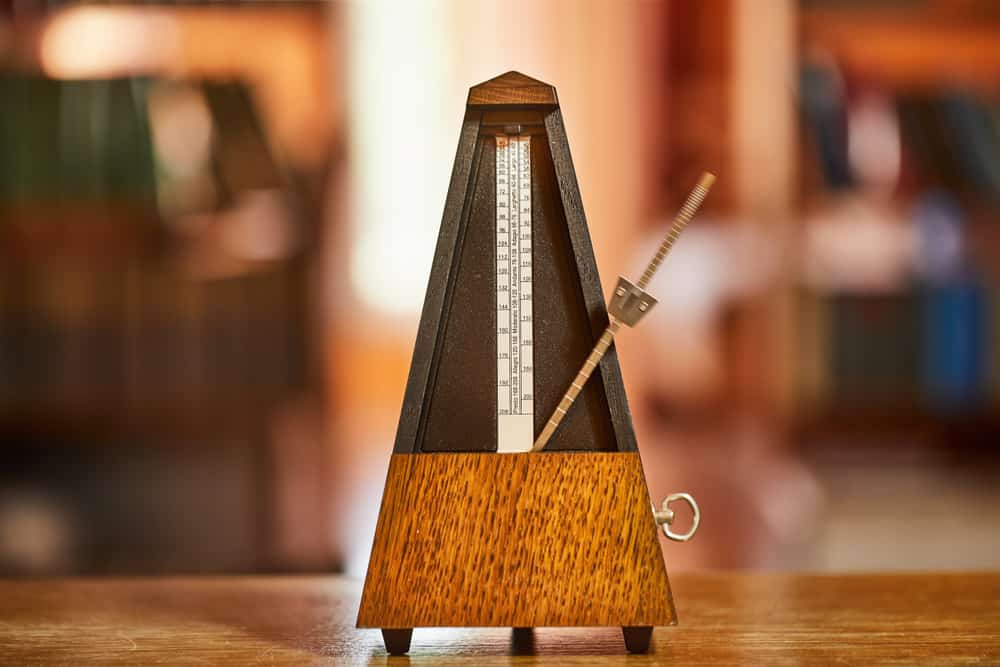
Have you ever tried playing the guitar, but you keep missing beats? You need to practice with a metronome to keep you in sync.
But how exactly do you practice the guitar with a metronome?
To play a perfect rhythm, you need to practice your guitar with a metronome. It’s a fundamental tool for improving your timing and rhythm. Every metronome is set to 120 BPM by default. You can either increase or reduce the value depending on the tempo you want to practice at.
If you’re playing on the 4/4 time or beat signature, you know four beats make a whole note. This means that you must strum four times for each note you play. To make strumming easy, you can audibly count along with the metronome. Increase the tempo from 120 BPM to 150 BPM and see how well you play along.
This guide will find different ways to set up and practice your guitar with a metronome.
What Is a Metronome?
Playing the guitar isn’t all about learning chords and strumming away. There’s a unique rhythm you have to follow as you play. It doesn’t matter how excellent your chords sound. If you miss your beats, you’ll sound off. That’s where the metronome comes in.
What exactly is the metronome?
Imagine a little pendulum that swings freely and counts each second that passes. Every second, there’s a tick, and it continues doing that until you stop it. A metronome is like an inverted pendulum that keeps ticking at a particular pace. Depending on the pace, you’re to play a chord after several ticks.
In short, a metronome tells you when to pause, play or change to another chord. The ticks serve as a guide to keep you in rhythm. Think of it as a time marker.
How To Practice Guitar With a Metronome

If you want to be good at playing the guitar at different tempos without missing a beat, then practicing with a metronome is highly important. Here’s how:
Choose a Metronome
For every practice, you need the right tool. If you want to practice your guitar with a metronome, you need to get a metronome alongside your guitar.
There are different types of metronomes, but overall serving the same purpose.
You can either opt for a small mechanical or electronic metronome that can sit idly while you strum or download a metronome app on your phone.
With $30, you can buy a solid mechanical metronome from a local music store. But $15 can get you an electronic metronome as well.
If you’re not keen on spending money on a metronome, just scroll through your mobile app store to download a free metronome app.
Tune Your Metronome
Now that you have your metronome, it’s time to tune it to the pace or tempo you want to practice with.
The basic tempo for practicing the guitar is the 4/4 time or beat signature.
Four quarter notes equal four beats, and when you play or count four beats, that makes a semibreve or whole note.
Every metronome is set to 120 BPM (beats per minute). You can either increase or reduce the value depending on the tempo you want to play with.
Strum Along Beat for Beat
Practice is about breaking a whole item down into smaller and simpler bits until you can play the more complex whole.
In tuning your metronome, set it to the most basic pace or tempo you need in tuning your metronome. If you can’t play at the default 120 BPM, scale it to your comfortable tempo.
Once you have the right tempo for you, strum all six strings of your guitar according to the ticking of your metronome.
Remember, four beats is a whole note. So after striking the fourth beat, you’re to switch from the chord or note you’re playing to another one.
For instance, think of playing a chord progression like C, Em, G, and D on a 4/4 time or beat signature. As the metronome ticks each beat, strum along to it.
After strumming four beats to C Major, switch to E minor on the following best: a new 4/4 time or beat signature.
Count 1, 2, 3 4 as you strum a note, then repeat for every note you’re to play.
Count Along With the Metronome
At this point, you might begin to feel as though practicing with a metronome is too complicated. It’s not. Once you get its hang, you’ll easily practice with it.
The best way to synch or play in beat with the metronome is to count. If you’re playing on the 4/4 time or beat signature, you know four beats make a whole note. This means that you must strum four times for each note you play.
To make your strumming easy, you can audibly count along with the metronome. Other methods for counting would be to tap your feet, bob your head, mentally count or hum along with the metronome.
Go Higher
The metronome is to help you maintain your rhythm. Now’s the time to go higher if you’ve started playing comfortably with the 4/4 time or beat signature.
Raising the tempo ensures that you can conveniently play at a higher tempo without missing the beat. Increase the tempo from 120 BPM to 150 BPM and see how well you can play along.
Practice with the higher tempo until you can conveniently play it, then switch back to a lower tempo. The goal is to be a master of both tempos.
Turn Off the Metronome
Once you’re done practicing with the metronome, turn it off and try to play the guitar. The goal is to see if you’re still missing beats.
Suppose you’re still missing beats. Practice again with the metronome and turn it off to check your progress. When you do this consistently, you’ll get better.
Conclusion
Practicing your guitar with a metronome is meant to refine how you play such that you don’t miss any beat. It’s a fundamental training tool that can train your mind, ears, and fingers to maintain a rhythm. To practice your guitar with a metronome, you only need to get one, tune it and strum along. It may take a while, but you’ll get better at your timing and rhythm.









